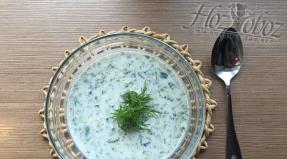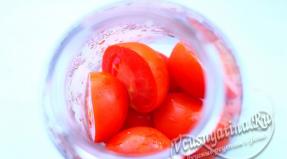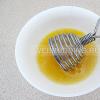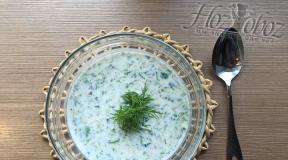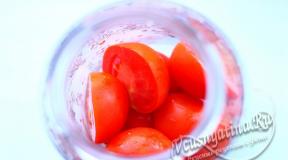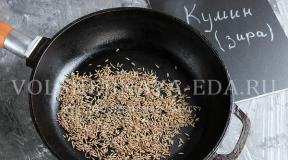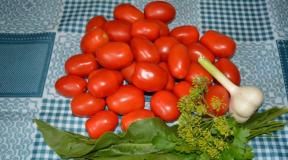News of health, medicine and longevity. “Bad” letter E: myths and facts about food additives Dangerous food additives for children
Our products contain a huge number of different dyes, flavor enhancers, preservatives and other things. Naturally, out of ignorance, we are terribly afraid of these additives. Because we watch TV, read various articles on these topics, and they regularly scare us with scary and incomprehensible Eshki. I became interested in figuring out: how dangerous are they and are they dangerous at all? Especially considering the fact that food additives are present in almost all food products and drinks. So…
What is a dietary supplement?
These are various special chemicals added to products to give them certain properties. For example…
Flavorings are needed to give a certain smell, preservatives extend the shelf life and consumption of products, dyes are needed to give the desired color, sweeteners make products sweet, stabilizers preserve physical and Chemical properties products, but antioxidants are needed to preserve vitamins.
Well, do you need nutritional supplements or not? It seems to me that the answer is obvious: we need it!

For any heat treatment(boiling, frying, stewing) various chemical reactions occur in potatoes, as a result of which new substances are formed. But these substances were not in raw potatoes. Hence the conclusion: there is no need to be afraid of food additives! You just need to know which food additives can really cause harm and avoid products containing them .
It is absolutely impossible to produce products on an industrial scale without special additives. Such products will spoil quickly. Therefore, you should not believe the labels “no preservatives” or “no food additives.” The manufacturer who writes this on the packaging is openly deceiving you. It’s just that he (the manufacturer) used acetic acid as a preservative , but it is not on the official list of preservatives. Although in essence it is. But its esters or salts are included, these are food additives E260 - E269.
Nutritional supplements by number
Each dietary supplement has its own unique number or code, which consists of English letter E and a three-digit number. Additives from E100 to E199 are dyes, E200 to E299 are preservatives, followed by a hundred antioxidants, and so on.
It is worth noting that food E-additives themselves do not pose a particular threat, and many are found in excess in natural products or can be produced by the human body. For example, the E270 supplement is lactic acid, which is formed in the cells of our body during the breakdown of glucose.
A lot of people are scared of monosodium glutamate (monosodium salt), which is essentially an amino acid that is abundantly found in nature. It is found in abundance in tomatoes, milk, mushrooms, meat, corn, fish, cheese and cottage cheese.
Of course, there are additives that can be called harmful, if not for one thing: to cause harm to health, their quantity must be significantly higher than that used by product manufacturers. But for allergy sufferers and children, it is better to use foods containing such additives with caution. They can accumulate in the body.
Ideally, you need to remember all the harmful and dangerous Eshki, but in practice this is not feasible. Therefore, I suggest you familiarize yourself with the most dangerous ones.

Doctors, especially nutritionists, do not advise eating a lot of sausage, because of the preservative and color improver E250 it contains. (sodium nitrite) because it is toxic in large quantities. But without it, sausage would not be eaten at all; the risk of contracting botulism would be very high. It is strange that for some reason these same researchers and critics of food additives do not tell consumers that, for example, one kilogram of broccoli or spinach contains exactly the same amount of sodium nitrite as 50! kilograms of “Doctor’s” sausage.
Now the question: Through which product is it more realistic to get this “harmful” preservative by eating a kilogram of broccoli or 50 kilograms of sausage? I think everyone understands what the answer will be.
The healthy and well-known cranberry contains more E211 (sodium benzoate) than manufacturers use when canning food.
Many people are afraid to give their children sweet soda for fear of sweeteners. There is some truth in this; the sugar substitute – aspartame (E951) breaks down into amino acids in the body and releases methanol. And methanol is undoubtedly poison. But the question again is the amount of dose consumed. An adult weighing 70 kg would need to eat 266 aspartame tablets or drink 25 liters of diet cola per day to be harmful to health. So how realistic is this? That's right, not realistic at all.
Nutritionists joke: V fresh apple contains additives E296, E141, E330, E440 and there will probably be a couple more. And what? Now you won't eat apples and won't give them to your children? Doubtful.

Some manufacturers also have a good sense of humor. For example, on the label of the Buratino drink you can read the ingredients: water, carbon dioxide, sweetener, lemon acid E330, preservative E211 and flavor identical to natural. Everything would be fine if it were lemonade or an orange drink, but it’s not clear what natural aroma we should feel from Buratino. Maybe the smell of freshly cut wood?
Finally
As you can see, there's nothing very wrong with food additives No. I would even say that they are not intended to harm, but, on the contrary, to help both us and product manufacturers. Otherwise, how would we consume sausage, candy, cookies, ice cream or soda? No way. You just need to be aware and carefully study the composition of the product you are purchasing. . It’s also good to know which Eshki are dangerous to consume. You should be especially careful when buying products for children, the elderly and pregnant women.
Are those who advocate natural products without food additives really that honest? Why then do they deliberately keep silent about how many different chemicals are used to grow vegetables and fruits?
Another question is which is more dangerous: a dose of a food additive verified by manufacturers or uncontrolled watering of cucumbers, tomatoes and other supposedly natural products in fields and greenhouses with various chemicals. A huge number of people, including children, are poisoned every year by watermelons alone. So, it’s worth thinking about: what is the purpose of such a serious information war against food additives and who benefits from it? Maybe producers of “natural” products?
Elena Belokonova
When it comes to nutritional supplements, most people express skepticism without having enough information. That's why this article will clear things up by presenting five simple truths:
Truth #1: We are the masters of our own destiny.
Believe it or not, there are two simple and undeniable reasons why two out of every three adults die prematurely every year: deficiency. nutrients and lack of physical activity.
Indeed, five of the six leading causes of death among adults worldwide - heart disease, lung disease, cancer, diabetes and stroke - are very closely related to these two risk and lifestyle factors. Nutritional deficiencies and physical inactivity interact to weaken our immune defenses and create an environment ripe for chronic disease and premature death.
At the same time, our immune system spends a huge amount of energy every day in the fight against the consequences of these two factors. The various cells and molecules of our immune system work incredibly hard in this daily battle. However, when they ultimately lose, the following occurs:
The lining of our vital organs (blood vessels, intestines, respiratory tract) is damaged. Once this happens, the core cells of our body are exposed to dangerous toxins that they have no natural defenses against.
Once toxins reach the cells of our major organs, these cells cease to perform their intended functions. As a result, a number of chronic diseases develop in the body.
A comprehensive explanation of how all this happens in the body would take several pages. However, believe me that the mechanism of destruction is almost identical in all five major diseases listed above.
The bottom line is this: We can significantly improve our body's health over time by improving the quality of the nutrients we consume and increasing our daily physical activity. And, in our opinion, nutritional supplements play an important role in achieving results. Inspirit company - vibrating massagers wholesale from a warehouse in Moscow.
Truth #2: Supplements Improve Diet and Exercise Results
If you are serious about working to reduce your risk of developing one or more of the five major chronic diseases mentioned above, great importance will have the following for you. You will need to not only increase your level of daily physical activity, but also completely switch to healthy foods in your diet, this is especially true for people with poor health. At the same time, it is necessary to consume dietary supplements that provide your body with additional support.
In fact, the intention of taking nutritional supplements as adjunctive therapy is the right choice for those who want to manage their health while improving their diet and increasing physical activity. Taking supplements will not work wonders and will not replace you medications(at least in most cases). However, dietary supplements will help you feel better over the long term.
In other words, food supplements are mandatory dietary companions and physical exercise.
This statement is especially true if you have already been diagnosed with one or more of the five major diseases listed above. Each of these factors, dietary changes and exercise, can significantly reduce your risk of mortality and improve your quality of life, but nutritional supplements can make diet and exercise much easier.
Truth #3: A New Look at Supplements
When we mention supplements, most doctors show us their skepticism about the benefits of taking them. However, according to a recent study, about 70 percent of the adult population are consumers of one or more types of dietary supplements.
What is the reason for this mistrust? For the most part, this is due to the lack of sufficient information, a small number of studies whose results would be considered convincing by the scientific community.
The fact is that most published studies of dietary supplements have been conducted on laboratory animals and human tissue samples, since it is easier and cheaper to control for variables that could affect the results of the experiment. Although the results of most of these studies were convincing, subsequent experiments using humans as subjects did not always provide the same results.
Moreover, some dietary supplement companies further damage their reputation with doctors and scientists by making unsubstantiated claims about the effectiveness of their products that are not supported by any research.
We are not trying to convince you that the opinion traditional medicine is unreasonable and the consumption of dietary supplements will only benefit your body. But, did you know that about 68 percent of medical specialists take nutritional supplements from time to time? Additionally, one survey found that 72 percent of physicians and 89 percent of nurses participating in the study were at least occasional users of dietary supplements.
Based on this, we can conclude that, despite the presence of contradictory and, at times, insufficiently strong scientific evidence of the benefits of taking nutritional supplements, research results indicate that they do not have a negative effect on the human body.
Therefore, despite the current mistrust among scientists regarding the use of dietary supplements, as well as the differing views of nutritionists on recommended dosage, doctors and researchers use supplements in the same way as the rest of us.
Truth #4: Diet and exercise alone are not enough to improve health.
Regular physical activity and a consistent, nutrient-rich diet are two obvious steps anyone can take to improve their health. Most studies have shown that people who exercise at moderate intensity for 30 minutes a day, five days a week, have significantly better health outcomes. low level risk of developing chronic diseases and lower mortality rates compared to those who exercise less than three days a week. In fact, in a recent study, scientists found that moderate physical activity could reduce the risk of mortality by 19 percent.
In addition, multiple studies have shown that dietary intake with high content fruits, vegetables, nuts, whole grains, fish/seafood, olive oil and red wine, which is called the Mediterranean diet, contributes to a significant reduction in the development of chronic diseases compared to the conventional diet. However, scientists noted that the mortality rate when following a Mediterranean diet is reduced by 50 percent, compared with a diet consisting of large amounts of red meat, sugar/salt, overloaded with processed foods, and foods high in saturated fat.
A Mediterranean-style diet is also associated with significant reductions in heart disease, stroke, lung disease and diabetes. This fact can be observed especially clearly among residents of southern Mediterranean countries such as Spain, Portugal, Italy, Greece and France, compared to other developed countries. In addition, these countries, with the exception of Italy and France, have much lower cancer incidence rates. Researchers point out that the Mediterranean diet helps prevent heart disease, stroke, diabetes and cancer, given that the population of southern Mediterranean countries is the least physically active.
However, are proper diet and exercise enough? Many doctors would agree that these two steps alone are more than enough to protect your long-term health. Of course, this seems like a reasonable conclusion based on research, but only if you have followed doctors' recommendations your entire life. However, we all know that most people do not diet or exercise throughout their lives. For those of us who fall into this category, healthy exercise and a healthy diet will certainly help. However, it should be taken into account that we have probably already caused damage to our body through poor lifestyle choices over a long period of time, so we need to take some additional steps beyond changing our diet and exercising. This statement is especially true for those who are unwilling or unable to accept and support healthy image life and proper nutrition, as well as for those who already suffer from various chronic diseases.
Namely, many studies have found significant nutritional deficiencies in people who already suffer from chronic diseases. For example, consuming vitamin D supplements. We have previously written that high levels of this vitamin in the body lead to. A recent study of smokers and patients with chronic obstructive pulmonary disease found that 31 percent of smokers with normal lung function were found to be vitamin D deficient, while 77 percent of people with chronic obstructive pulmonary disease had insufficient vitamin D levels. Another study Study found that 75 percent of heart attack patients had insufficient vitamin D levels. In addition, 34 percent of those with type 2 diabetes who took part in the study had critically low vitamin D levels. Finally, 67 percent of 224 breast cancer patients were found to be deficient in this vital nutrient.
Regarding vitamin C deficiency, a study of patients suffering from advanced cancer showed that 30 percent of them had a lack of vitamin C in their body. In a recent health study of a group of nonsmoking adults, researchers found that among men with the lowest plasma levels of vitamin C, the risk of death from a heart attack increased by 57 percent, and the risk of death from cancer increased by 62 percent.
Thus, there is sufficient scientific evidence to suggest a connection between the development of chronic diseases and lack of nutrients in the body.
Given that many people are unwilling or unable to adapt their lifestyle to meet all the recommendations, scientists have turned to the study of dietary supplements to help fill this gap. Numerous studies have shown the beneficial effects of essential nutrient supplementation on a variety of chronic diseases.
Truth #5: It's never too late to start
Sometimes we can give up on our health, believing that it is too late to change anything. Maybe you already suffer from heart disease. Maybe you already have overweight and you think you'll never be thin again. Or maybe you've convinced yourself that at your age there's no point in trying to change anything.
Please change your point of view. The human body has a remarkable ability to recover. If you give it this opportunity, your body will instantly react positively. This does not necessarily mean that you will be able to stop the disease or turn back time, because the consequences bad habits that lead to the development of chronic diseases will not disappear overnight. However, every step in the right direction to improve your diet and regular exercise will take effect quickly and you will be able to feel the results yourself.
For example, the results of a study examining the effects of exercise on the health of people with severe lung, heart and cancer diseases showed marked improvements in key indicators of physical health and a significant improvement in the quality of life of project participants. Also, as an example, we can cite a recent study aimed at studying the effects of pulmonary rehabilitation in patients with chronic obstructive pulmonary disease with varying severity of the disease. At the same time, scientists noted that even in the most severe patients an improvement in respiratory symptoms and more was recorded. high quality life.
The same effect is seen in people with chronic illnesses who eat a healthy diet. For example, a study on the effects of a Mediterranean diet on the health of heart attack survivors showed a decrease in inflammatory markers. of cardio-vascular system(C-reactive protein and interleukin-6) compared with other patients consuming normal food.
So, everyone needs to take dietary supplements. Combined with a healthier diet and regular physical activity, they can help improve treatment outcomes and facilitate the body's ability to absorb nutrients.
Food additives, designated by the letter E, are included in almost all food products. How safe are they for health?The food industry has always used various additives, but until 1953, manufacturers honestly informed customers about all the ingredients in the product. But after the European Commission on Additives proposed a letter designation system using the E code, the composition of processed foods, sausages, sweets and much more in our diet has become something of a secret.
Hence the fear of buyers: is there something dangerous to health hidden under the next designation with the letter E? Let's try to find the truth and find out which food additives should be excluded from the family menu.
Food additives themselves do not have any effect on the human body.
harmful influence, scientists say. However, they warn that
ingredients labeled E react with other substances
in the body can have unpredictable effects on our health.
Dangerous food additives for children
The child's body is less protected from harmful external influences. Therefore, it is important for parents to carefully monitor the quality of the products that make up their children’s menu. And if the child already eats adult food, you need to know that some of the additives with the E index are not recommended in baby food.
E330 - citric acid, which is part of many people's favorite carbonated drinks, when consumed provokes the secretion of gastric juice and can lead to the development of gastritis.
E951 - aspartame, an artificial sugar substitute, is used in the production of many sweets. However, there is an assumption that this dietary supplement contributes to the development of a genetic mutation leading to a rare disease - phenylketonuria.
E216 and E217 - propyl ether and sodium salt. These preservatives are found in filled chocolate and candies and, if consumed in excess, can cause food poisoning.
E102 - tartrazine. A dye used in the manufacture of confectionery, sweets and ice cream. However, tartrazine can cause food allergies.
E400-499 - thickeners, stabilizers to increase the viscosity of food products. They are used to make yoghurts. Possible consequences of abuse of this dietary supplement may include diseases of the digestive tract.
Dangerous food additives for women
Pregnant women and nursing mothers are advised to adhere to the diet. However, even foods that are allowed while expecting or breastfeeding should be passed through a “sieve” of nutritional supplements. The fact is that some of them can cause harm like women's health, and for children. Let's give examples.
E957 - thaumatin. Officially, its use in the food industry is prohibited, but the risk of purchasing counterfeit products still exists. Therefore, it is worth remembering: E-957 disrupts hormonal balance.
E128 is a red dye Red 2G with a carcinogenic effect, used in the production of sausages. Can lead to abnormal development of the fetus during pregnancy and congenital pathologies.
E250 - sodium nitrite - dye, seasoning and preservative, used for making sausages. It is noteworthy that E250 is approved for use in Russia, but prohibited in the European Union. Possible consequences effects of this food additive on female body- development of fetal hypoxia during pregnancy, decrease in the content of vitamins in the body, increased excitability of the nervous system.
Dangerous Dietary Supplements for Men
There is little information about the harmful effects of food additives on the male body. Of course, representatives of the stronger half of humanity, like children and women, are not immune from the development of allergic reactions, cancer due to exposure to ingredients with the E index, as well as negative influence of these substances on the systems and functions of the body.
There is one nutritional supplement that men need to know by sight. It is known that E520, or aluminum sulfate, used as a starch modifier, can negatively affect the male reproductive system if abused.
How to protect yourself from the harmful effects of food additives
It is not easy to keep your family healthy when food products contain more artificial additives than natural ingredients. What should I do? Perhaps awareness of the consequences of abusing food additives will lead many to think about healthy eating.
And to do this, you should open your refrigerator, evaluate the ratio of sausages, sausages, smoked meats and canned goods in it with the amount of fresh fruits, vegetables and home-made food. If the comparison is in favor of “chemistry,” then it’s time to start a new day by cleaning out the refrigerator and then going to the store for the right food.
And although it is almost impossible to avoid products with certain E on the label, try to keep their amount in your daily diet small.
What do we know about nutritional supplements? Are they as scary as we are always told? Let's read and find out...
Every day, without knowing it, we eat dozens and hundreds of different nutritional supplements. There is a widespread fear of them among the people, especially if they are designated by the letter E in the composition of products.
However, chemists assure time after time that products produced in accordance with the rules are even safer than those grown in your own garden. After all, the manufacturer knows thoroughly what substances are present in his product, and you can only guess what your vegetables absorbed from the ground and air.
However, food chemistry still scares us and, it must be said, for good reason. But the point is often not in the potential danger of this or that additive, but in human habits themselves, which still do not get along well with modern industry.
Where does the letter E come from?
Food additives are used to give food a certain taste, color or consistency, to increase shelf life or disinfection. For ease of classification, in Europe it is customary to assign a number with the prefix E to various additives - these are the same endless “Es” that you find in products.
- numbers from E100 to E199 are assigned to various types of dyes,
- from E200 to E299 - for preservatives,
- from E300 to E399 - for antioxidants,
- from E400 to E499 - for stabilizers, thickeners and emulsifiers,
- from E500 to E599 - for various pH level regulators,
- from E600 to E699 - for flavor enhancers and flavorings.
- The following numbers are filled with various types of antibiotics, gases for packaging, sweeteners and foaming agents, as well as other substances used in the food industry.
Of course, it is impossible for a consumer to understand the entire list of food additives, even with the appropriate education. Therefore, the use of certain substances in the manufacture of products is regulated by the state.
Let's pay attention to the most interesting nutritional supplements - from those that are well known to every consumer and to those that the consumer would prefer not to know about.
Monosodium glutamate
This is perhaps one of the most popular food additives - almost every food lover knows about it. It is found in those products that, despite their low cost, seem rich in taste - these are chips, crackers, noodles instant cooking and other cheap snacks. It can often be found in sausages and various semi-finished products. This additive is designated by code E621.
It has long been believed that monosodium glutamate works as a taste enhancer, stimulating all the receptors on the tongue. But recently, scientists have been convinced of the opposite - this seasoning acts only on certain receptors and, thus, is responsible for a completely separate taste. It has been known in oriental cuisine since time immemorial - in Japan it is called “umami,” which literally translates as “pleasant taste.”
The independent taste of monosodium glutamate is difficult to describe, since it is almost elusive, but together with other products it can create that incredible combination. It is characteristic that the seasoning based on monosodium glutamate sold in Japan is called “essence of taste.” It is especially good in combination with meat and salty dishes, but the main thing is not to overdo it.
Disputes about the harm of monosodium glutamate have been going on for the second century, but over the past time, not a single serious study has shown that this substance can be dangerous when consumed in moderate doses. Moreover, some modern scientific research suggests that in old age
«
umami" may even be useful.
On the other hand, parents often prohibit their children from eating chips or other foods with MSG too often. Too rich a taste causes something like addiction in children, after which they refuse to eat regular food.
At the same time, monosodium glutamate is found in a huge number of natural products - meat, vegetables, mushrooms. And in celery, for example, there is even more of it than in the same chips.
Sodium nitrite
We are all accustomed to the fact that sausages and frankfurters have
«
“meat” red color, but few people realize that this is far from their natural color. If it were not for sodium nitrite, the usual sausage would be ash-gray in color. Such a product would not be very attractive to the average consumer.
However, sodium nitrite is not only a dye, but primarily also a preservative. That is why it belongs to the second hundred food additives and its code is E250. The main purpose of sodium nitrite is to combat the terrible bacteria that causes botulism.
For all its advantages, sodium nitrite is far from harmless. It is a toxic substance to humans, although it is also used in medicine in small doses. In addition, there is evidence that sodium nitrite may contribute to the development of cancer.
That is why the use of E250 in the European Union is currently being discussed by the expert community. In our country, there are no restrictions on this food additive yet and it can be found in almost any Russian sausage product.
Silica
This food additive is less known among consumers, although no less popular among manufacturers. Silicon dioxide is often used in the production of crackers, as well as cheap instant coffee - it prevents
«
sintering" of the product when cooked at high processing temperatures.
This additive, number E551, can also be found in mayonnaise, cheap boiled sausage and finished products, which can be stored for a long time at room temperature.
All this is quite normal for a food additive, if not for one thing - silicon dioxide, as readers familiar with chemistry may have already noticed, is ordinary sand. And although many of you didn’t think that you regularly eat real sand, silicon dioxide itself is absolutely harmless. It is also used in medicine - an effective sorbent is made on its basis, which helps with poisoning.
Aluminum
You won’t be satisfied with sand alone, so you can safely fortify yourself with metal. True, not in our country - in Russia, Ukraine, Australia, as well as a number of other countries, the food additive E173, which hides aluminum, is prohibited.
But what does aluminum do to food? It's simple - aluminum powder is used as a coloring and gives food a metallic tint. It is added to cakes, various dragees and sweets.
Aluminum was banned because of the dubious consequences of its use - some researchers believe that the metal can be deposited in the human body and affect metabolism, in particular, cause skeletal diseases such as osteoporosis. Although aluminum is normally excreted in the urine.
In addition, a person can consume quite a large amount of aluminum even without the E173 dietary supplement if he eats from appropriate containers or drinks drinks from aluminum cans. On average, from human body up to 15 mg of aluminum per day is excreted.
It is worth adding that two more metals are hidden under the food additive numbers E174 and E175 - silver and gold. Both can also be used as dyes
By the way, they are allowed in our country), however, due to their high cost, they are extremely rare.
Borax
This substance, which is a salt based on boron and sodium, is an integral part of the modern chemical industry - it is used in the manufacture of fire extinguishers, glass, detergents, for exterminating insects and treating horse hooves.
Such a useful thing could not pass by the food industry, where borax is used as a preservative. True, for some time now it has been banned in the United States due to its adverse health effects, especially in men. According to research, Borax has negative effects on reproductive function and may even harm an unborn baby.
Borax is still used in other countries. But, basically, only for one product - caviar. So the next time you choose red caviar, try to do without E285 in the composition, although it is used in very small doses.
Sulfur dioxide
This gas has been known to man as a food additive for a very long time - back in Ancient Rome it was used as
«
wine improver."
Today, sulfur dioxide is used very widely in the food industry - it is used to process meat and fruits, it is added to drinks, mainly to wine. Also, this additive under the name E220 can often be found in jams and ice cream.
Basics useful property sulfur dioxide is antibacterial, so it is most often used as a preservative.
At the same time, sulfur dioxide is extremely toxic to humans - a slight excess of the daily dose can provoke abdominal pain in chronic patients.
Tolerance to sulfur dioxide greatly depends on the individual properties of each person. Headache after drinking wine occurs precisely because of E220, but only people with impaired stomach acidity suffer from it. Sulfur dioxide also destroys vitamin B1 and can provoke an allergic reaction in asthmatics.
Carmine
This red dye, number E120, is not found often due to its relatively high cost. However, you can still find it in the supermarket - in meat and fish products, sweets, and carbonated drinks. But whether you will use it after you find out what it is made from is the question.
And carmine is made from dried insects. The female cochineal mealybug, which spends its entire life on a single leaf of the plant, is dried and crushed, after which carminic acid is extracted from it. The next derivative of the process is the red dye.
If you think that this is some exotic way of obtaining a nutritional supplement, then you are mistaken - something else is also obtained from insects.
Shellac
Some music lovers and antique lovers may be familiar with this substance - until the 40s of the last century, it was used to produce gramophone records. Ladies may also be familiar with shellac as a substance used for manicure.
And shellac is a natural resin, which is a waste product of the red beetle that lives in the forests of Southeast Asia.
In addition to plates and manicure products, shellac is also quite popular in the food industry - there it is known under the code E904 and is used as a glazing agent. Vegetables and fruits are coated with shellac so that they retain their bright color longer, candies and other sweets, nuts, coffee beans, and much more.
Of course, additives made from insects undergo deep chemical processing, so there is nothing left directly from them. On the other hand, due to their natural origin, these substances are considered absolutely harmless.
L-cysteine
This amino acid is widely used in baking various baked goods - it makes the dough softer and more viscous. If you eat a donut, loaf, cake or something like that, then most likely you are also consuming the E920 dietary supplement.
Now the question is - do you think there is a nastier way to obtain a nutritional supplement than by processing insects? And here is the answer - L-cysteine is obtained from the processing of human hair. Sometimes, however, bird feathers are used, but more often they use hair, which is usually bought in China.
It is curious that in the United States, conservative activists regularly demand a ban on this food additive, believing that eating it is tantamount to cannibalism. But for Arabs and Jews there is a kosher way to obtain L-cysteine, but it is several times more expensive than usual.
Skatol
Not the last one in this nice list We have skatole, the substance responsible for the characteristic smell of feces. However, nature is very cleverly designed - skatole smells of feces only if there is a lot of it, but if the substance is dissolved, then its smell decomposes into other, more pleasant ones - milky, floral or strawberry.
Therefore, skatole is actively used in the production of flavorings for perfumes, cigarettes and strawberry ice cream.
Bon appetit!
Three kilograms chemical substances. This is the amount that is swallowed per year by the average consumer of a wide variety of, sometimes absolutely familiar, products: muffins, for example, or marmalade. Dyes, emulsifiers, sealants, thickeners are now present in literally everything. Naturally, the question arises: why do manufacturers add them to food and how harmless are these substances?
Experts agreed that “food additives are the general name for natural or synthetic chemicals added to food products in order to give them certain properties (improving taste and smell, increasing nutritional value, preventing product spoilage, etc.) that are not are consumed as independent food products.”
The wording is quite clear and understandable. However, not everything in this matter is simple. Much depends on the honesty and basic decency of manufacturers, on what exactly and in what quantities they use to give products a marketable appearance.
Serial number of taste.
Nutritional supplements are not an invention of our high-tech age. Salt, soda, and spices have been known to people since time immemorial. But the real flourishing of their use began in the twentieth century - the century of food chemistry. There were high hopes for supplements. And they fully met expectations. With their help, it was possible to create a large assortment of appetizing, long-lasting and at the same time less labor-intensive products.
Having won recognition, the “improvers” were put into production. The sausages turned soft pink, the yoghurts became freshly fruity, and the muffins were fluffy and unstale. The “youth” and attractiveness of the products is ensured by the additives, which are used as dyes, emulsifiers, sealants, thickeners, gelling agents, glazing agents, flavor and odor enhancers, preservatives...
Chewing gum and Coca Cola, which were super popular in the 20th century, got their unique taste thanks to food additives. And the most amazing thing is that 100 years ago the food additive for cola was cocaine. It got its name from the coca plant, a shrub from whose leaves cocaine is obtained.
Much has changed in the area of safety in the use of food additives since then. Once upon a time, the use of methamphetamine was considered harmless; now it is classified as a “hard drug”. Not so long ago in Russia, “Mars” chocolates contained a substance that is now included in all countries of the world in the list of prohibited food additives. It is quite possible that after several decades, some dye generously added to products will be considered harmful.
The mechanism for the appearance and use of a food additive is as follows: first, the additive is developed, then it undergoes testing from several weeks to several months, or even years. If the tests are successful, then the regulatory organization of the country where the additive was developed recommends it for widespread use.
In Europe, safety regulations require that the presence of a food additive be indicated on the packaging in the list of ingredients.
According to the accepted European classification, all additives are designated by the letter “E” (the initial letter in the word “Europe”).
For example, E152 is completely harmless activated carbon,
E1404 is starch, and E500 is soda.
The largest group of food additives after the letter E contains only 3 numbers.
Classification of food additives:
E100-E182 denote dyes that enhance or restore the color of a product. They can be natural (such as beta-carotene or carminic acid dyes) or synthetic.
The main goal in in this case is the desire to increase sales. Dyes have absolutely no effect on taste qualities food and the process of its absorption by the human body. Dyes are added to lemonade, Coca-Cola and similar drinks, sweets, puddings, ice cream, alcohol, margarine and cheeses.
Natural colors are extracted from a range of fruits and vegetables, such as red beets, sweet peppers, oranges or spinach. Artificial dyes are synthesized chemically. Food products containing natural colors are generally considered not to be hazardous to health.
Caution should be exercised with artificial colors. They can cause allergies and, under certain conditions, even cause cancer.
Codes E200-E299- preservatives that increase the shelf life of products by protecting them from microbes, fungi and bacteriophages. This group also includes chemical sterilizing additives used during the ripening of wines, as well as disinfectants.
E300-E399- antioxidants that protect foods from oxidation, for example, from rancidity of fats and discoloration of cut vegetables and fruits.
E400-E499- stabilizers, thickeners, emulsifiers, the purpose of which is to maintain the desired consistency of the product, as well as increase its viscosity.
500-E599- pH regulators and anti-caking agents.
E600-E699- flavorings and flavor enhancers
The most common and most dangerous of this group is glutamate.
E700-E899. There are no food additives under these numbers yet; these codes are reserved for new substances whose appearance is just around the corner.
E900-E999- defoamers
Not so long ago, in the 90s, a second, less extensive group appeared, in the designation of which after the letter E there are 4 digits E1000-E1521. This group of additives is responsible for ensuring that products such as flour, sugar, salt do not absorb moisture and remain crumbly (these are glazing agents, separators, sealants, flour and bread improvers, texturizers, packaging gases, sweeteners).
Within these various groups there are nutritional supplements that provide clear benefits to the body and are called “functional.” But experts are also increasingly speaking in favor of tightening control over the use of food additives due to their dangerous influence on the human limit.
First, let’s figure out what they are—functional additives and “functional products”—and what benefits they provide.
Since the second half of the 20th century, vitamins and microelements have been added to many food products, which has made it possible to almost completely eliminate diseases associated with a deficiency of one or another element. Thus, cheilosis, angular stomatitis, glossitis, seborrheic dermatitis, conjunctivitis and keratitis associated with a lack of vitamin B2, riboflavin (dye E101, which gives products a beautiful yellow color) are a thing of the past; scurvy due to vitamin C deficiency, ascorbic acid(antioxidant E300); anemia, caused by a lack of vitamin E, tocopherol (antioxidant E306).
And adding additives containing probiotic forms of beneficial bacteria to foods and drinks strengthens immunity and health. All nutritionists agree on this.
These bacteria, taken daily in yoghurts, kefir and other fermented milk products, restore the natural balance of intestinal microflora and thus improve its functioning.
Functional additives also include very important essential fatty acids of the omega-3 class. Their deficiency is associated with hyperactivity in children and depression in adults. They are the most important means in the prevention of atherosclerosis.
Bread and eggs enriched with omega-3 are produced.
Into bakery products for the purpose of their “health improvement”
Bran is added, which contains a large amount of plant fiber. It acts as a brush for the intestines, improves its functioning and helps eliminate toxins and waste.
When choosing such products, you should pay attention not only to the useful food additive, but also to the composition of such a product as a whole. Energy drinks with guarana may also contain excess simple sugar. The choice of “functional” products must be reasonable and based on specific goals. If you have increased level cholesterol, it makes sense to buy products with special additives.
medicus.ru
